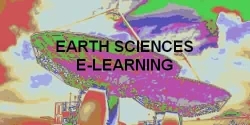How to Use a Silva Compass
How to Use a Silva Compass
adapted to the Southern Hemisphere from Kjetil Kjernsmosillustrated guide on How to use a compass kjetikj@astro.uio.no
Using the compass alone
Using the compass in interaction with a map
Finding the Direction Without a
Compass
see also how to use the Brunton
compass - separate page...
Using the compass alone
This is a very easy lesson, and I would say, not sufficient for those who would like to travel safely in unfamiliar terrain. The first thing you need to learn, are the directions. North, South, East and West. Look at the figure and learn how they are. North is the most important.
There are several kinds of compasses, one kind to attach to the map, one kind to attach to your thumb. The thumb-compass is used mostly by orienteers who just want to run fast, and this is the kind of compass I normally use.
But not in this tutorial. I would recommend the third kind of compass. Let's take a look at it:
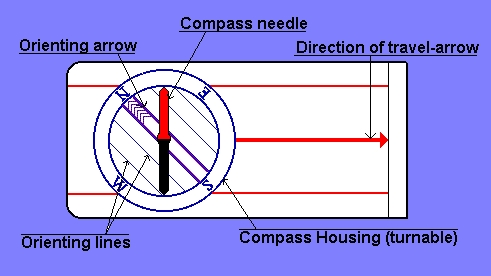
You see this red and black arrow? We call it the compass needle . Well, on some compasses it might be red and white for instance, but the point is, the red part of it is always pointing towards the earth's magnetic north pole. Got that? That's basically what you need to know. It's as simple as that.
But if you don't want to go north, but a different direction? Hang on and I'll tell you.
You've got this turnable thing on your compass. We call it the Compass housing . On the edge of the compass housing, you will probably have a scale. From 0 to 360 or from 0 to 400. Those are the degrees or the azimuth (or you may also call it the bearing in some contexts). And you should have the letters N, S, W and E for North, South, West and East. If you want to go in a direction between two of these, you would combine them. If you would like to go in a direction just between North and West, you simply say: "I would like to go Northwest " .
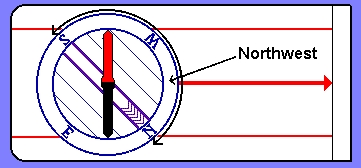
Let's use that as an example: You want to go northwest. What you do, is that you find out where on the compass housing northwest is. Then you turn the compass housing so that northwest on the housing comes exactly there where the large direction of travel-arrow meets the housing.
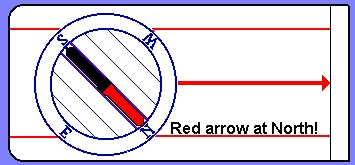
Hold the compass in your hand. And you'll have to hold it quite flat, so that the compass needle can turn. Then turn yourself, your hand, the entire compass, just make sure the compass housing doesn't turn, and turn it until the compass needle is aligned with the lines inside the compass housing.
 Now, time to be careful!. It is
extremely important that the red, north part of the compass needle
points at north in the compass housing. If south points at north, you
would walk off in the exact opposite direction of what you want! And
it's a very common mistake among beginners. So always take a second look
to make sure you did it right!
Now, time to be careful!. It is
extremely important that the red, north part of the compass needle
points at north in the compass housing. If south points at north, you
would walk off in the exact opposite direction of what you want! And
it's a very common mistake among beginners. So always take a second look
to make sure you did it right!A second problem might be local magnetic attractions. If you are carrying something of iron or something like that, it might disturb the arrow. Even a staple in your map might be a problem. Make sure there is nothing of the sort around. There is a possibility for magnetic attractions in the soil as well, " magnetic deviation ", but they are rarely seen. Might occur if you're in a mining district.
When you are sure you've got it right, walk off in the direction the direction of travel-arrow is pointing. To avoid getting off the course, make sure to look at the compass quite frequently, say every hundred meters at least.
But you shouldn't stare down on the compass. Once you have the direction, aim on some point in the distance, and go there. But this gets more important when you use a map.
There is something you should look for to avoid going in the opposite direction: The Sun. At noon, the sun is roughly in South (or in the north on the southern hemisphere), so if you are heading north and have the sun in your face, it should ring a bell.
When do you need this technique?
If you are out there without a map, and you don't know where you are, but you know that there is a road, trail, stream, river or something long and big you can't miss if you go in the right direction. And you know in what direction you must go to get there, at least approximately what direction.
Then all you need to do, is to turn the compass housing, so that the direction you want to go in, is where the direction of travel-arrow meets the housing. And follow the above steps.
But why isn't this sufficient? It is not very accurate. You are going in the right direction, and you won't go around in circles, but you're very lucky if you hit a small spot this way. And that's why I'm not talking about declination here.
And because that is something connected with the use of maps. But if you have a mental image of the map and know what it is, do think about it. But I think you won't be able to be so accurate so the declination won't make a difference.
If you are taking a long hike in unfamiliar terrain, you should always carry a good map that covers the terrain. Especially if you are leaving the trail. It is in this interaction between the map and a compass, that the compass becomes really valuable.
Using the compass in interaction with a map
This is the important lesson, and you should learn it well.
It's when you use both compass and map the compass is really good, and you will be able to navigate safely and accurately in terrain you've never been before without following trails. But it'll take some training and experience, though. I am not covering map reading here, guess you would have to consult other sources for that, but the lesson will be useful if you have a sense of what a map says.
Here is our compass again:

The principles are much the same but this time, you are using the map to tell you which way is correct instead of your intuition.
Take a map. In our first example, we look at a map made for orienteering, and it is very detailed. Well, not really. We look at a fictitious map I drew myself, but never mind. To the point.
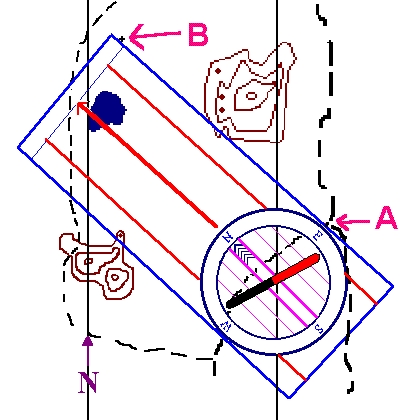
You want to go from the trail-crossing at A, to the rock at B. Of course, to use this method successfully, you'll have to know you really are at A.
What you do, is that you put your compass on the map so that the edge of the compass is at A. The edge you must be using, is the edge that is parallel to the direction of travel arrow. And then, put B somewhere along the same edge, like it is on the drawing. Of course, you could use the direction arrow itself, or one of the parallel lines, but usually, it's more convenient to use the edge. At this point, some instructors say that you should use a pencil and draw a line along your course.
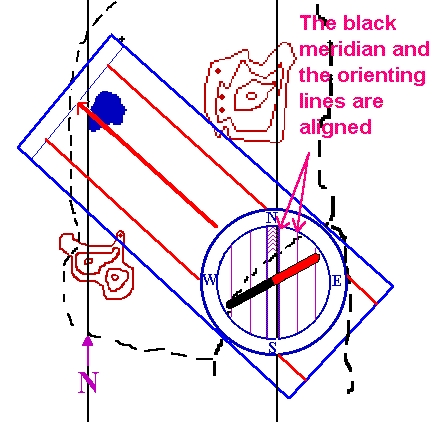
I would recommend against it. First, it takes a lot of time, but offers no enhancement in accuracy of the method. Second, if you have wet weather, it may destroy your map, or if it is windy, you may loose it. You should keep your map (preferably in a sealed) transparent plastic bag, and if it is windy, tied up, so it can't blow away. But most important is that any drawings may hide important details on the map.
 Time to be careful again! The edge
of the compass, or rather the direction arrow, must point from A to B!
And again, if you do t his wrong, you'll walk off in the exact opposite
direction of what you want. So take a second look. Beginners often make
this mistake as well.
Time to be careful again! The edge
of the compass, or rather the direction arrow, must point from A to B!
And again, if you do t his wrong, you'll walk off in the exact opposite
direction of what you want. So take a second look. Beginners often make
this mistake as well.Finding the Direction Without a Compass
You are lost. I mean really lost. Standing in the middle of nowhere, and you have no idea where to go. If you are really in trouble, remember two things first of all: stay calm, think rationally, and you can survive a long time without food. What you need is to drink.
Further thoughts about extreme survival skills is beyond the scope of this page, seek advice elsewhere beyond this introduction. This page deals with the situation of finding your way, without the aid of a compass. What you have, is the sun, the stars, and the nature around you.
This page is mainly about the northern hemisphere of the earth, actually north of 23.5 °, because I have never been to the southern hemisphere myself (would like to go there of course!). The methods described do of course apply to the southern hemisphere as well, but in some places there may be a need to swap north and south to get it right. I hope you are able to figure it out.
For a start, it may be a good idea to climb a hill, and get a good look around. Try to see traces of human activity. If you see nothing, you should try to figure out in what direction would be the best to travel. If you haven't got a map, try to draw one if you can of the terrain in front of you, and try to mark off where north is, using the methods below. If you have got a map, try to determine where you are. Remember, you don't want to climb more hills than you have to. Also you should carefully consider not to climb if you are very tired. In that case you should consider staying where you are. Consult other sources for information on how to make it easy for rescuers.
Let us start with the most accurate method. This method requires that you have a pretty clear sky, though, and takes a lot of time. One of the advantages is that you don't need any equipment. You would need a straight pole about 1 meter (or a yard) long, two small sticks or rocks, another stick (or rock) that needs to be a little sharp, and something that can act as a string.
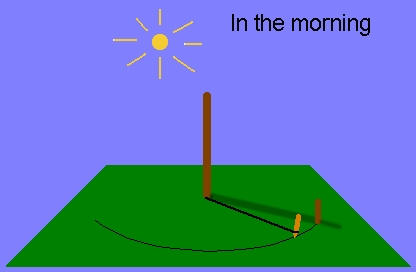
In the morning, at least before noon, the trick starts. Stick the long pole in the ground, upright. The ground around the pole needs to be horizontal. Now, you can place one of the little sticks in the ground exactly where the shadow of the pole ends, like on the figure. Then tie the string to the base of the pole, and tie the little, sharp stick, to the other end, so that when the string is stretched it reaches exactly the little stick standing there in the soil. Then, scratch half a circle in the soil with your sharp little stick, and wait... Wait. Wait until the evening. During the day, the shadow will get shorter and shorter, until noon, when it gets longer again. At noon, when the shadow is at its shortest, you may want to mark the point. The shadow is now pointing north (if you are north of 23.5 ° north). It is however not very easy to see exactly when this is, but it is useful anyway. Finally, the shadow reaches your circle again, and when it does, place your other little stick at the spot where the shadow ends. If you haven't got a string, you could use a pole that has the right length, or try to come up with some other improvised solution. Just make sure what you draw is a circle.
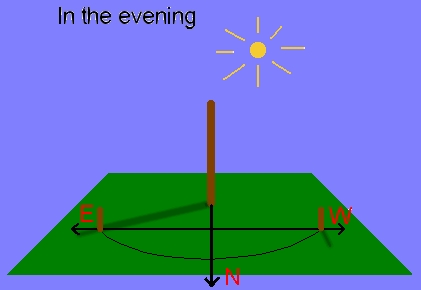
Now, the line from the first stick to the second is west-east, like on the figure. Actually, you may want to mark points regurlarly, because any two points that have exactly the same distance from the base of the pole will give the West-East line. If it is partly cloudy, this may be a good idea.
There is a short, fast version of this one as well. This is only approximate, though, and the further away from the equator you get, the more inaccurate is it. You don't need the sharp stick and the string. Just wait 20 minutes between placing each of the sticks, and the line between the two sticks will be approximately west-east, like on the figure. Often, you wouldn't need anything more accurate.
At night, you can navigate after the stars. You should, however, be careful with walking, it is easy to stumble and fall and get injured, and also easy to lose sight of the stars as you go, and you might start going around in circles. Often it will also be more physically and mentally demanding.
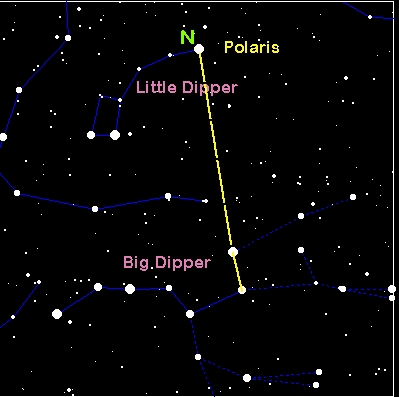
In the northern hemisphere, there is a star that is almost exactly in the north at all times, the Polaris . It is pretty easy to find, if you know the "Big Dipper". (Everybody knows the Big Dipper (or the Plough)?) Take the two stars at the end of the "Big Dipper", and make an imaginary line "upwards", and extend it five times the distance between the two stars. There you have it - Polaris. That way is always north. The figure is by Kathy Miles .
In the southern hemisphere, you would have to find the Southern Cross .
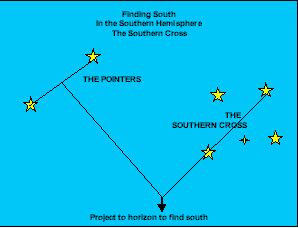
That way is roughly south.
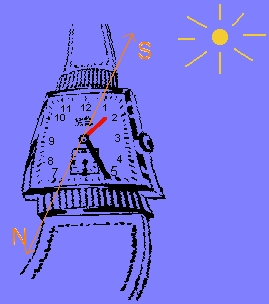
If you have an analog wrist watch, you can use the time to find north. Hold your watch up in front of you, and let the short hand, red on the figure, that indicates hours point at the sun. While holding it like this, cut the angle between the red arrow and 12 o'clock in two, ( noonwards if the time is before 6am or after 6pm), that way is south. (The reason you need to cut it in two, is because the clock takes two rotations while the sun takes one around the earth, it is of course the other way around, but never mind.)
Many people wear digital watches these days (I do myself, if I wear one at all). If you do, draw an analog watch face on a piece of paper, and then mark the hour hand on using the digital watch. The rest of the method is identical.
This method can be used even when it is pretty foggy. Although you may not be able to see the sun, it may still cast a shadow. If you take up a straw or a tiny stick, and you may see a shadow. You just have to remember that the shadow points the opposite way from the sun, but the rest of it is quite similar as above.
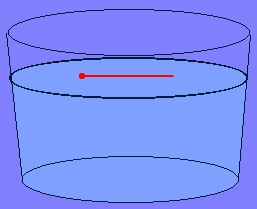
Want to make your own compass?
Sure.
You need a needleand a glass of water. A needle can in fact float on the water, or that is, on the surface tension forces if put carefully on the surface. Just put it carefully down on the surface of the water. This demands a lot of patience though. There are three tricks that makes it go easier. One: Put the needle on a piece of paper. If the paper floats too, there is no problem, and if the paper sinks, it'll probably leave the needle. If you put some grease on the needle that isn't water-based, it'll go easier, or if you put it carefully down with a fork or something. Once it has got there, it stays there pretty good.
If the needle is magnetic, it will act as a normal compass and be very accurate. A problem is though, that you don't know north from south.

